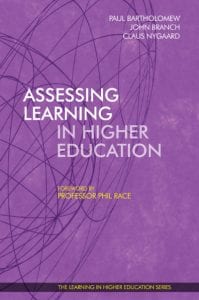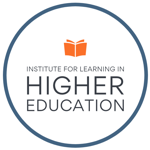Assessment for Learning (AFL) in Higher Education – five necessary steps
Assessment for learning (AFL) is an assessment method designed to both evaluate and improve student learning. It sounds simple, but in fact, it is rather complex. Why?
Professor Claus Nygaard, a co-author of more than 20 books on learning-centred higher education, elaborates on assessment for learning (AFL) and describes five important steps you may follow when you engage in assessment for learning.
You teach, and teach, and teach…
Imagine a situation where you teach a group of students. As you stand in front of the students, you do your best to get your message across to them. To inspire them. Get them fascinated. Inspire them to learn.
You may be with 25 students in a classroom. Or you may find yourself in a lecture hall with several hundred students present.
You do not know if, how, why, where, and when students are learning
No matter which setting you are teaching in, you face one crucial challenge. You do not know if students are learning, how they are learning, why they are learning, where they are learning, and when they are learning. What you see is a student audience. You have no access to the learning process as such as you stand there teaching.
We have done our best to compensate for our lack of insight into student learning.
Because we know that the purpose of education is for students to learn, we have done our best to design ways of measuring (what we believe is) student learning. Traditionally, we use what is called summative assessment to get insight into student learning.
Summative assessment as a poor choice
Summative assessment is a method that allows the teacher to measure the student’s understanding of what has been taught in class. Typically, summative assessment occurs at the end of a course/module to test the student against a set of standardised criteria. The course/module description will often contain such criteria for students to read when preparing for the summative assessment (exam).

Summative assessment may be designed in a variety of ways (this list is not complete, it is just included here to get you thinking about your own summative assessment practice):
- an oral assessment, where the teacher questions the student or the student makes an oral presentation or speech.
- a written assessment, where the student writes a report, essay or narrative.
- a performance assessment, where the student makes a performance to show their skills.
- a rubric assessment, where the student takes a predefined quiz or fills in a predefined matrix.
Whatever summative assessment method we are using, the problem is still the same. We do not know if, how, why, where, and when students are learning.
- a student may have known all answers before the course/module started.
- a student may have been demotivated during the course/module and ends up disengaged and less learning.
- a student may have stayed away from classes but still learned a lot.
- a student may have learned enough in the final few days before the exam to be assessed positively against the required standardised criteria.
- (as you think more about the possible drawbacks of summative assessment, you may continue this list yourself).
Formative assessment as a possible way forward when assessing for learning
Now, imagine if you could look into the heads of your students. To follow their learning. Then you would not stand there in front of the crowd thinking about if your teaching was successful or not. Certainly, you wouldn’t have to wait until the exam to know.
And MUCH more importantly: students’ wouldn’t have to wait until the exam to find out if they had learned enough to be assessed against the standardised criteria for your course/module.
Luckily, we have a way to obtain knowledge of students’ learning process. The method is called formative assessment, which is a method designed to gathered information about student learning. Originally the term was coined by Michael Scriven, 1967, as a method to assess the effectiveness of a curriculum. Today, formative assessment is also referred to as assessment for learning (AFL).
Formative assessment is a sort of on-the-fly assessment method, where students are engaged to reflect and discuss their own learning as it takes place. It is a method that centres the effect of the learning activity in the present and has students’ voice their opinions and understandings of their own experiences.
Formative assessment (assessment for learning) may be designed in a variety of ways (this list too is not complete, it is also just included here to get you thinking about your own formative assessment practice):
- goal-setting, where the student formulates their own learning goals and defines methods for reaching those. Students can also do this exercise in groups.
- definition of quality, where the student defines quality and comes up with suggestions on evaluating such quality. This exercise too can be done in groups of students.
- feedback, where the teacher gives immediate feedback to the student based on the student’s engagement in a learning activity. Of course, teachers may also provide feedback about engagement, activity, and outcome to groups of students simultaneously.
- peer-feedback, where students’ give immediate feedback to other students based on students’ engagement in a learning activity.
- self-assessment, where the student engages in the verbalisation of learning by assesses own learning method, learning process, and learning outcome. Students may also practise self-assessment in pairs or groups.
- questioning, where the student is asked questions to promote discussion and reflection about own learning method, learning process, and learning outcome. Questioning as a formative assessment method may also be done by groups of students.
From these few examples, it may be clear that formative assessment methods help both teacher and students learn more about how, why, where, and when students are learning.
The main advantage of formative assessment for learning (AFL) is that the student’s learning process is continuously focused. It is about assessing student engagement, student reflection and student learning while the learning process is ongoing, rather than measuring an absolute result at the exam.
Assessment for learning (AFL) leads to benefits for students
Assessment for learning may well lead to several benefits for students:
- constructive feedback may increase the motivation to learn.
- setting own learning goals may increase the responsibility for own learning process.
- self-assessment may increase academic and personal awareness and reflectivity.
- peer-assessment may improve academic responsibility and constructive communication skills.
- (as you think more about the possible benefits of formative assessment for learning, you may continue this list yourself).
Five necessary steps in assessment for learning (AFL)
Step 1: define learning
In their 2011-article, A proposed methodology for contextualised evaluation in higher education, Nygaard & Belluigi argue that higher education evaluation has to have a starting point, the definition of learning. I shall argue here that the first important step in assessment for learning is precisely a definition of learning itself. How can anyone work with assessment for learning without a definition of learning?
What is learning to you? Is learning to acquire predefined knowledge? Is learning an ongoing process in which knowledge is constructed? Who owns the definition of learning? Who owns the learning process?
Step 2: define assessment.
Another crucial step is the definition of assessment. Because, how can anyone work with assessment for learning without a definition of assessment? Referring back to the above descriptions of summative and formative assessment, essential questions for clarification arise:
What is assessment to you? How do you assess learning? At what time do you assess learning? Who should benefit from the assessment of learning? Is assessment done to justify the teachers’ work? Is assessment done to grade students? Is assessment done to increase the learning outcomes of students? Is assessment done to help students better understand and engage in their learning process?
Step 3: define methods.
The third important step to take when assessing for learning is to define the methods to be used by teachers and students. And clearly describe where, when, and why these methods are used. Because how can anyone expect teachers or students to engage in assessment for learning methods on-the-fly, if such are not well-defined, well-chosen, and well-implemented?
How do you define methods suitable for assessment for learning? Where in the learning process are such methods used? By whom? For what purpose?
Step 4: engage stakeholders.
A fourth important step is to engage a variety of stakeholders in assessment for learning. Because learning is not a private and individual process for students, neither is it the teacher’s sole responsibility to design curricula for learning. During their education, students follow multiple courses/modules. Engage teachers from various disciplines to discuss the many meanings of assessment for learning. Include students as a stakeholder group too. Also, engage alumni who may have interesting perspectives on the longevity of their learning. And engage members of the surrounding business community who may offer essential understandings of students’ transferrable skills and thus give valuable inputs to how assessment for learning may occur.
Step 5: design curriculum
The fifth important step is now to start designing the curriculum so that all the activities supporting students’ learning process rest on integrated definitions of learning, assessment, and methods – which furthermore have been discussed with a variety of important stakeholders. NOT until now are you allowed to design a curriculum.
If you reflect on traditional approaches to curriculum design, often the curriculum comes first. Without steps 1-4, the curriculum may end up just like an instrumental structure of pre-defined lectures and exercises, which students’ attend because they have to.
We don’t want that. And we don’t want such instrumental teaching and learning behaviour to be assessed using summative assessment methods.
Conclusion – use formative assessment methods as the cornerstone in your assessment for learning (AFL) in higher education.
I am sure that my conclusion doesn’t come as a surprise for anyone. It is rather one-sided in favour of the formative assessment. It is coloured by my 25 years in higher education, where I have continuously worked to improve learning-centred activities.
My personal belief is based on thousands of meetings with students and teachers – that implementing assessment for learning (AFL) may improve the success of teaching and learning activities in higher education.
References in this article about assessment for learning (AFL) in higher education:
Scriven, M. (1967). The methodology of evaluation. In Stake, R. E. (ed.). Curriculum evaluation. Chicago: Rand McNally. American Educational Research Association (monograph series on evaluation, no. 1.
Nygaard, C., & Belluigi, D. Z. (2011). A Proposed Methodology for Contextualised Evaluation in Higher Education. Assessment & Evaluation in Higher Education, 36(6), 657-671 (LINK TO ARTICLE).


